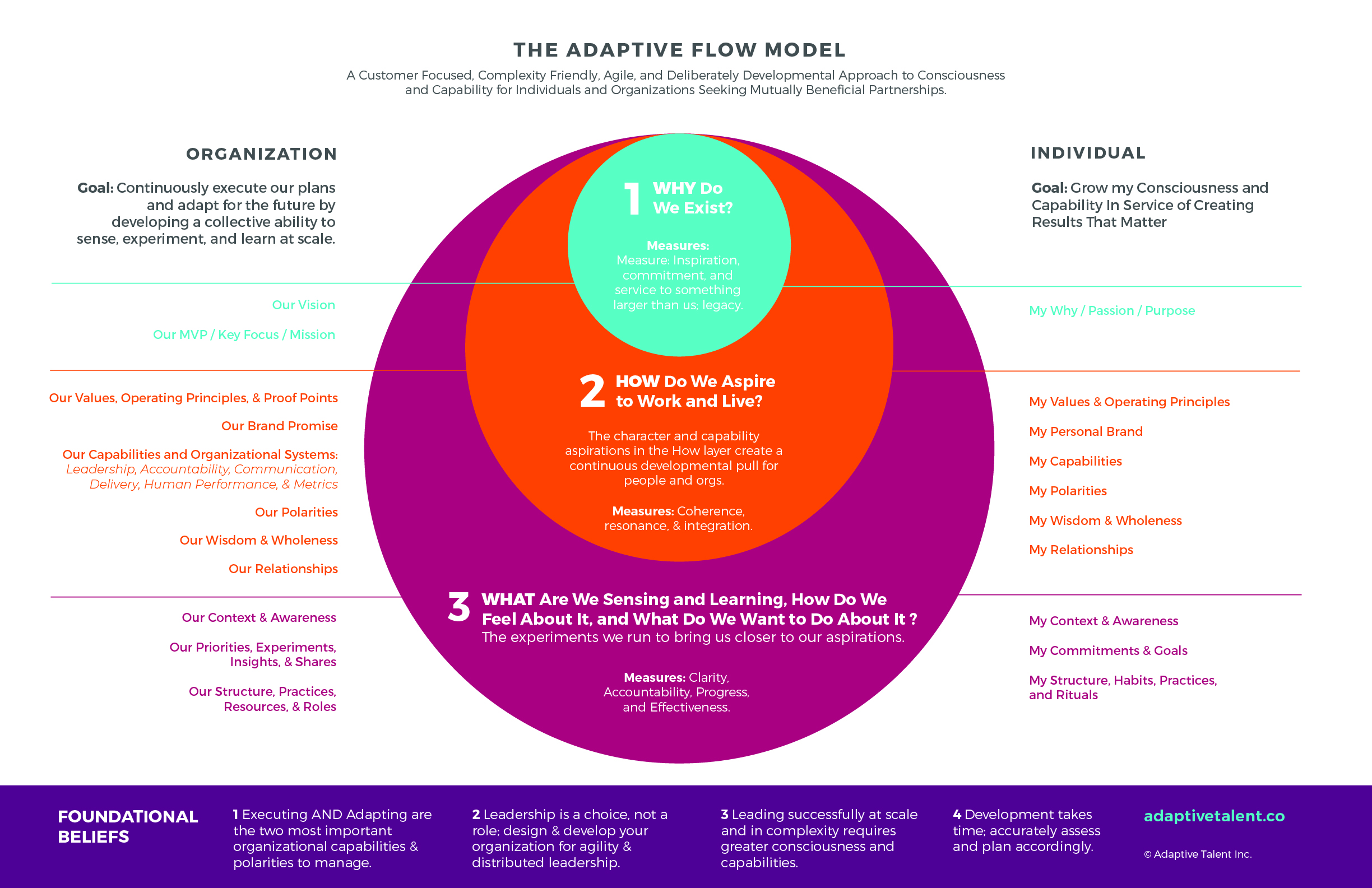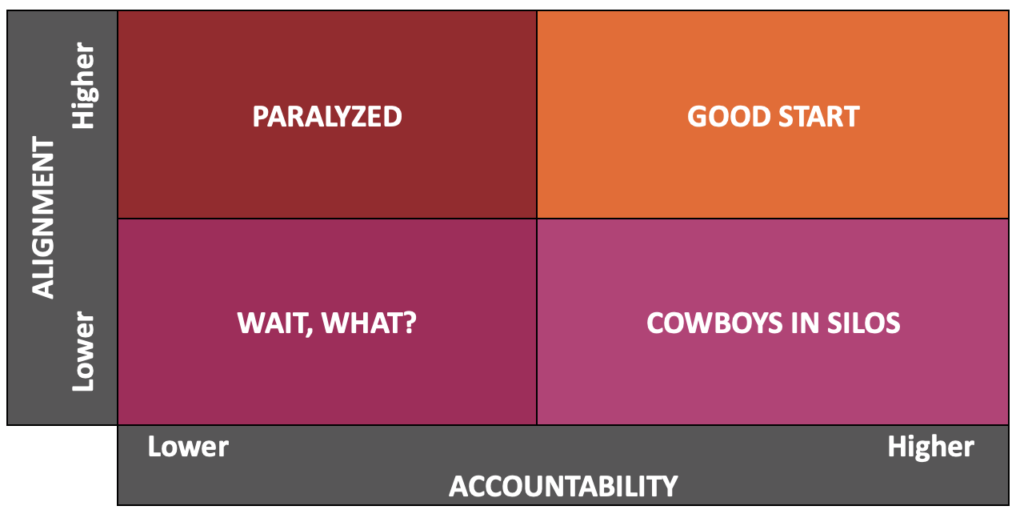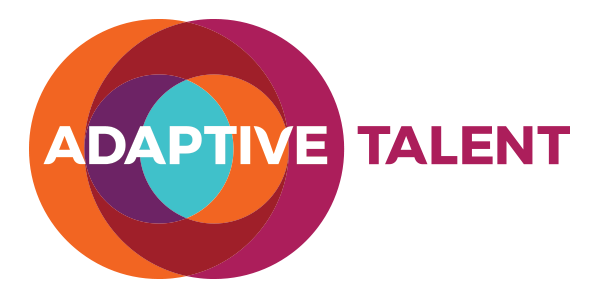This blog post is written especially for CEOs and executive staff to help them think differently about the relationship between alignment and accountability, the two hardest things to achieve within an organization if it is to reliably execute its plans and simultaneously adapt for the future so they can stay relevant over time to their customers. You cannot execute well or adapt successfully if your organization cannot sense, experiment, and learn at scale in a targeted, coherent way. What enables a results-focused learning organization? In my experience alignment and accountability are both fleeting states that optimize the potential to sense, experiment, and learn at scale in service of creating results that matter over time. For those interested in quantum mechanics, if I understand it properly, aligned and accountable people are like the plane of possibility from which all manifestations occur. If you had to prioritize a handful of things to get right, I’d ensure your teams were highly aligned and accountable. Said in a different way, because the natural order of a group of people working together is more like herding kittens it will take every team member to act like a leader and take responsibility for their role and the success of the whole team. Those two states of being are powerful counter forces/energies against the natural tendency towards disorder and stasis.
Successfully and continuously executing your short term plans and adapting for the future has never been more important and difficult. The world is more disrupted via technology, politics, societal changes like workforce participation, generational expectations, and birthrate replacement rates, inflation, fiscal crises, and new competitors. It’s not surprising that executives are overwhelmed and exhausted; simply reacting to the world can overwhelm, let alone leading innovation and other adaptive activities (or having a successful personal life and a healthy mind and body). Creating and reacting are like ascending and descending currents meeting in a river; it’s part of life so effective teams need to be able to create and react in a coherent, sustainable way.
By alignment I mean shared understanding held by a group of people about their purpose, aspirations, values and principles, strategies, priorities, limitations, etc. that help them focus and direct their limited resources to achieve results that matter. As an example, see our Adaptive Flow model below. In my mind, alignment would encompass the organizational elements in the WHY, HOW, and WHAT layers. As you might imagine, it’s a mutually beneficial partnership when each individual’s elements in their Why, HOW, and WHAT layers are matched in a deliberately developmental way to co-create results that matter to the person and to her/his teammates (aka the organization).

You’ll notice that the word alignment is not on the model because it’s not just one thing but many elements coherently defined individually and smartly integrated and managed over time. All healthy systems (your body, your relationships with loved ones, colleagues, your community, etc.) have differentiated parts and the right amount of integration for optimal functioning. I do not believe most leaders and executive teams know how to translate the many elements on the left into something useable in design thinking exercises, and in particular I don’t think I’ve seen good examples where the integration across those elements is coherent, easily understandable, linked in a detailed and prioritized way to the human and organizational capital required to make it sufficiently successful. The particles are there…but bringing them to life as a living whole, managed, developed, and evolved thoughtfully by every employee is a rare thing. That said, you feel the hard work and authenticity as a consumer when you experience even a hint of it. Maybe Apple and its products, their design ethos, the feel of their retail stores, and their approach to employee training are an example, as might Nordstrom and their retail experience, or even Disney’s parks.
If you have ever tried to get everyone on your team to understand the business context, key strategies, goals, duties, and updates you understand that it’s surprisingly hard to do well. I joke with my clients that as their organizations grow they will experience a phenomenon I call “human density” which is the difficulty leaders experience communicating sufficiently well to ensure understanding and commitment. People don’t listen, they forget, they misunderstand, or they choose to interpret something more to their liking. Or you weren’t a very clear communicator, or your ideas are not well received. Or something happens and plans need to change, and suddenly there are competing priorities, screwed up dependencies, and resource challenges and you and your team need to lean into each other and get clear together. This is a critical point – the more your organization and people are operating in a complex environment, the more important it is for their inner game/consciousness and their capabilities be developed in advance in order to sense thoroughly, experiment smartly, and learn at scale in order to meet these challenges. Development takes time – especially the inner game – so assess accurately and plan accordingly.
Alignment gets harder if you’ve got turnover, highly specialized roles, or are functionally organized because sometimes the relative sub-priorities of one function may not sync up exactly with the other functional teams’ priorities. Or different functions may emphasize certain things more than other functions and integrating those things into an optimized cross-functional team “play book” can take time and a lot of effort. Often it’s the individual contributors or first level managers who have to figure this out so you’ll want to be especially targeted / supportive to help them understand the big picture and act in an aligned way.
Accountability can mean many things to people, but as I mentioned in our last blog on the “Six Systems of Organizational Effectiveness” accountability is knowing the results that must be achieved, by whom, using certain processes, frameworks, technology, standards, resources within certain boundaries like timing, staging, budgets. It’s also the accuracy and predictability of the actual status of these projects; you’re not accountable if you have no idea whether you’ll hit the goal. So maybe we can say it’s (a) clarity on the WHAT and (b) accuracy of your assessment.
A group will struggle to be accountable unless each member is accountable. Being accountable as a person is a way of being and is essential for achieving anything of value in life including long term relationships, child rearing, being a loving family member, friend, and colleague. Being accountable is liberating because it contributes to a positive upward spiral in all aspects of your life. If you do what you say, people will trust you more. If you cannot do what you said you will do but are proactive and respectful with others they will help you roll with life, and you will help them. When you are responsible for your life, and grow your consciousness and capabilities to take on more responsibilities for yourself and to be of service to others, you will earn the gift of greater freedom (financially, professionally, socially) because people want to be in relationship with capable, accountable people who get stuff done the right way.
In our Adaptive Flow model accountability happens in the WHAT layer, which are the experiments we’re running day to help us move closer to our aspirations (revenue, product/service success, developing new territories, etc.). I call them experiments because adaptable organizations focus on rapid learning by sensing, experimenting, and learning at scale (see this blog post for one example of how you might do it). If I only focus on the SWOT analysis, strategies, and goals without wrapping them up into a structured hypothesis at the beginning of our efforts I run the risk of people defending their ideas or rewriting history to protect their egos. I also miss a critical opportunity to develop the inner game / consciousness of every employee in a very practical, results-focused way. Why? Because one of the most important moves in adult development are adults self-authoring their purpose, values, and aspirations in life (even and especially if it might disappoint others or not exactly follow group norms) and then getting into the groove and making it happen. Turning your tacit beliefs into something explicit and actionable is challenging and people forget how many assumptions they hold without any real questioning or deeper understanding. So when we help people run structured hypothesis testing on their initiatives, processes, or really any organizational decision (org design, communications, support agreements, etc.) you are helping them get the hang of getting clear on what they believe, map the data and beliefs they hold about those things, and unemotionally state the guess they’re interesting in taking via a strategy and key goals. When learning faster and better is more important than looking good you have given yourself a competitive advantage. This is not normal activity inside an organization but I believe it is instrumental to continuous renewal and needs to be baked into the DNA of the company, celebrated via group gatherings (especially the stuff that turned out differently than expected, and the team’s reorientation and next set of experiments, etc.). Obviously the more you couple this with explicit developmental goals for each person and layer of the organization in a very transparent way, and people ask each other for help in specific ways that are mapped to the key deliverables and experiments underway, you will get multiple benefits simultaneously. Capacity is nested, so you always need to be aiming, assessing, and experimenting at all layers of the organization in service of creating results that matter.
So as you think about your own team’s alignment and accountability what do you notice? I created a simple 2×2 grid to diagnose (albeit in a cheeky way) the situation you may find yourself in. Keep in mind that there are many other variables at play that contribute to success, and a HUGE one is ensuring you have capable people with the right skills, experience, and ability to scale their leadership to match the velocity of your business.
 Let’s start with Higher Alignment and Higher Accountability: It’s a good start! Truly, if people are in sync conceptually, and are using systems, clear deliverables, processes, tools, check-ins and updates, and are personally accountable and sufficiently skilled to deliver then you are onto a pretty good start.
Let’s start with Higher Alignment and Higher Accountability: It’s a good start! Truly, if people are in sync conceptually, and are using systems, clear deliverables, processes, tools, check-ins and updates, and are personally accountable and sufficiently skilled to deliver then you are onto a pretty good start.
Higher Alignment and Lower Accountability: Paralyzed! People are clear conceptually but nobody is clear on roles, interdependencies, decision rights, or next steps. If you’ve ever been in a new group in a course and have been instructed on the goals for a new learning exercise and people are trying to figure out who does what then you’ve experienced this quadrant. It’s like understanding the game of basketball but unclear on your role on the team and the plays to be run.
Lower Alignment and Higher Accountability: Cowboys in Silos! Here people are doing their “thing” and are quite clear on their focus and decision rights. Their alignment to the bigger picture is lower perhaps because they’re delivering their quota, product, or service and the last thing they have time for is more time in meetings hearing about other teams’ plans. This is the heads-down quadrant. It has value and we need people to be focused, so the question for every employee is always to discern how much of the bigger picture should you understand and align your plans and actions against. If you don’t need to do that, and others agree, great. But don’t assume that and a good rule of thumb is to think about the adaption your company needs to make, and the implications for your function/business unit/cross-functional teams. Contrast that with today and the delta between the two gives you a very clear map of how much more your awareness needs to grow in order to support that new desired state.
Lower Alignment and Lower Accountability:Wait, What? This is the quadrant of Jeff Spicoli in Fast Times at Ridgemont High. OK, I’m being playful here…but the comparison isn’t too far off. This person or team isn’t aware at all, isn’t unaccountable, and is a nightmare for every executive. Alignment can be taught usually…if someone has the capacity to learn, retain, and integrate so they can be responsive.
Questions executive teams can reflect on regarding alignment (which by necessity includes some developmental questions):
- What are the most important things we need to deliver, develop, and change? How are those things related to each other?
- What polarities are most important for us to manage (balances to be struck), and how are t hose things related to each other? What would it look like if we got the best of both poles, and what are the downsides of each pole? What are the early warning indicators that we’re overpreferencing one pole and causing undesirable results?
- What do we need to be excellent at, and how would that be done so as to embody our purpose, values, and brand expectations (the proof points)?
- How do we step back and assess our most critical company capabilities from a developmental lens, and how does that reconcile with our FY targets? Would tightening / strengthening these prioritized capabilities be a higher priority than some of these targets? Are we being realistic?
- Are the execs properly assessing readiness, thoroughness, integration, next tier of leadership readiness (developmental needs) when deciding which strategies and goals to adopt?
- How is our individual and collective leadership directly contributing to our overall accountability, predictability, trust, and results? Are we all pulling in the same direction towards the same target?
- Where might we be working against ourselves and how do we want to manage that intentionally?
- What are the causes of the problems that “require” the exec team to swoop in and problem solve?
- How do we proactively re-engineer how we do our work to create more capacity for value creation and protection (adapt)? This needs to include functional, cross-functional, and role design.
- How do we overcome human density so everyone on the team truly has sufficient context and understanding (alignment) so we can then allow as much autonomy as warranted for faster responsiveness?
- What questions and criticisms or concerns do our employees, partners, and customers have for us relative to our next FY goals? How are those related to the above questions?
- How are we helping people align their focus to our highest priority items (above)? Where else can we reallocate human and organizational capital for higher ROI uses?
- How are our current processes and ways of staying in sync as a leadership team and organization working? What experiments do we want to run to help us improve execution?
- How are we proactively seeking developmental feedforward input on our individual and collective leadership?
Questions executive teams can reflect on regarding accountability:
1. How do the execs shift their focus from today to something further out? What FY focus for them would help ensure execution while also supporting innovation and growth?
2. How do we charter initiatives/projects for maximum clarity, impact/effectiveness, accountability, transparency, access, etc.?
3. How do we foster ownership and superb cross-functional collaboration (especially around interdependencies)?
4. Are we doing enough to clarify decision rights and resourcing up front?
5. Are we running the organization with sufficient accuracy and forecasting (data, systems, process)?
6. Are our plans / efforts sustainable?
7. Have we adequately assessed risk and mitigated against it?
8. How have we prioritized helping our teams with their growth and deliverables (active coaching to move from firefighting to true capacity up levelling)?
9. How do we foster shared learning, retrospectives, and continuous improvement?
10. How well do we prioritize as a company and make hard decisions, trade-offs? What’s on our parking lot list?
Let me close with a great quote from Jurgen Appelo in a super helpful blog post entitled “Balance High Cohesion with Low Coupling: “Complexity science teaches us that no part of a complex system knows what is going on in the entire system. Each piece can have deep knowledge of a small area or a shallow understanding of a wide area, but knowing everything about everything is not an option. In complex adaptive systems, the parts optimize their small areas. Still, because everything depends on everything else, the local optimizations of the parts trigger feedback (directly and indirectly) from all the others across the entire system. And through these feedback loops, the parts correct each other and nudge them in more favorable directions. This is how a whole complex system improves its fitness level.”
So where to start? I’d focus on your organization’s most pressing deliverables, and the things that need development and change. Consider using the Adaptive Flow model to identify the most relevant organization elements to those goals, and then define/populate them using existing content, refining, or starting over. You’re trying to answer the question “What element are important for us to manage intentionally, over time, for us to have the collective consciousness and capabilities that will allow us to meet our WHY layer and to do so in a way that aligns with our HOW layer. You can then assess current state, and then pick the handful of things that are most pressing that you can actually undertake without overwhelming your people. You will need to crawl, walk, and eventually you’ll gain speed and the team will get it and it’ll become more understandable and integrated. I intend on creating learning experiences for (a) HR leaders (b) executive teams wanting to do this work as a cohort with me and (c) possibly working with VCs to help their early stage founders understand the framework and begin to lay the groundwork for an integrated human and organizational development approach. I look forward to hearing people’s ideas and suggestions about this blog post, the Adaptive Flow model, and any ideas people have about how they’d want to use / improve this framework.
Image credit and thanks to: MARIOLA GROBELSKA
---
Adaptive Talent is a talent consultancy designed to help organizations achieve amazing results and ongoing adaptability. Founded in 2008 and based in Vancouver, Canada we offer retained and contingent search, assessments, training, leadership coaching (1:1 and group), leadership development programs, and culture & organizational development consulting.

